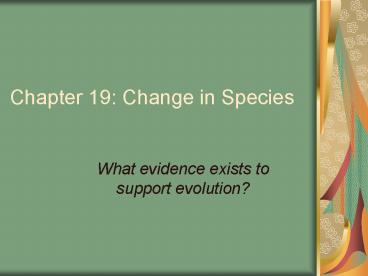Chapter 19: Change in Species - PowerPoint PPT Presentation
1 / 25
Title:
Chapter 19: Change in Species
Description:
Chapter 19: Change in Species What evidence exists to support evolution? Scientific Fields that Support Evolution Paleontology study of fossils Anatomy ... – PowerPoint PPT presentation
Number of Views:120
Avg rating:3.0/5.0
Title: Chapter 19: Change in Species
1
Chapter 19 Change in Species
- What evidence exists to support evolution?
2
Scientific Fields that Support Evolution
- Paleontology study of fossils
- Anatomy physiology study of body systems and
structures - Genetics study of DNA/genes
- Developmental biology study of embryos
development - Physical anthropology study changes in humans
3
19.1 Fossil Evidence
- Fossils physical remains of ancient organisms
- Fossils largest piece of evidence for evolution
4
19.1 Fossil Evidence
- Paleontology the study of fossils
- How do fossils offer information about change?
5
19.1 Fossil Evidence
- How do fossils offer information about change?
- They are a record of organisms that are extinct.
- Ancestral relationships can be based on where
they are found in relation to another fossil.
6
19.1 Fossil Evidence
- How do fossils offer information about change?
- They can show us the rate of evolutionary change.
- They are a clue to the physical structure of
living things (clues to behavior).
7
19.2 Ecology Homologies
- Homologous structures similarities between
species that suggest common ancestry - Homologies help biologists understand the history
of evolutionary changes
8
Example Forelimbs of vertebrates
Shows evidence that these organisms have an
ancestor in common.
9
Example Mouse/Fruit fly eyes
Gene homologies Scientists put the gene coding
for eyes in mice into an eyeless fruit fly
chromosome the fly grew eyes
10
Other Evidence for Evolution
- Vestigial Structures
- Structures that are no longer useful in an
organism (ex appendix, goosebumps, body hair,
etc. in humans) - Shows changes in organisms over time our
distant relatives needed them for something but
over time they no longer are needed
11
19.3 Genetic Molecular Evidence
- Darwins problem explaining how variations are
inherited - Study of genetics has provided more support for
the theory of evolution
12
19.3 Genetic Molecular Evidence
- Sources of genetic variation
- Mutation
- Recombination of alleles happens in sexually
reproducing organisms includes crossing over
fertilization to produce new combinations of genes
13
19.3 Genetic Molecular Evidence
- Genetic variation is the RAW MATERIAL OF
EVOLUTION!! - We use molecular data (DNA information) to see
the degree of relatedness between species more
DNA in common, more closely related.
14
Other Evidence for Evolution
- Embryos
- Early in embryonic development, it is very
difficult to tell different organisms apart. The
fact that we start off so similarly is evidence
we all came from a common ancestor.
15
Other Evidence Embryos
16
Other Evidence for Evolution
- Skulls
- Used often in human evolution changes in skull
shape/size show changes in humans over time
17
19.4 Process of Speciation
- Speciation the appearance of a new species
- Examples that have been observed primarily in
bacteria (because they reproduce and so, evolve
so quickly) new species of grain crossed
wheat and rye
18
19.4 Process of Speciation
- POPULATIONS EVOLVE, NOT INDIVIDUAL ORGANISMS
WITHIN A POPULATION!! - Speciation occurs when 2 populations become so
different in their genetic makeup, they can no
longer interbreed.
19
19.4 Process of Speciation
- Usually occurs as a result of isolation a small
population that gets isolated from the rest of
the population develops into its own species.
20
19.4 Process of Speciation
- 3 Types of Isolation
- 1. Geographic Isolation most common organisms
cannot come into contact with one another so they
cant interbreed (get separated by body of water,
mountain range, canyon, etc.)
21
19.4 Process of Speciation
- 3 types of isolation
- 2. Ecological isolation When two different
populations adapt to different niches in a habitat
22
19.4 Process of Speciation
- 3 types of isolation
- 3. Reproductive isolation (also behavioral) the
mating patterns of a small group of organisms
becomes so different from the main group that
they become reproductively isolated
23
19.5 Patterns in Evolution
- Two ideas on Progress of Evolution
- 1. Gradualism Speciation evolutionary change
occurred through the accumulation of many gradual
constant changes
24
19.5 Patterns in Evolution
- Two ideas on Progress of Evolution
- 2. Punctuated Equilibrium Short period of
rapid change just after a population becomes
isolated and forms a new species, after which the
process slows and approaches stasis
25
(No Transcript)































